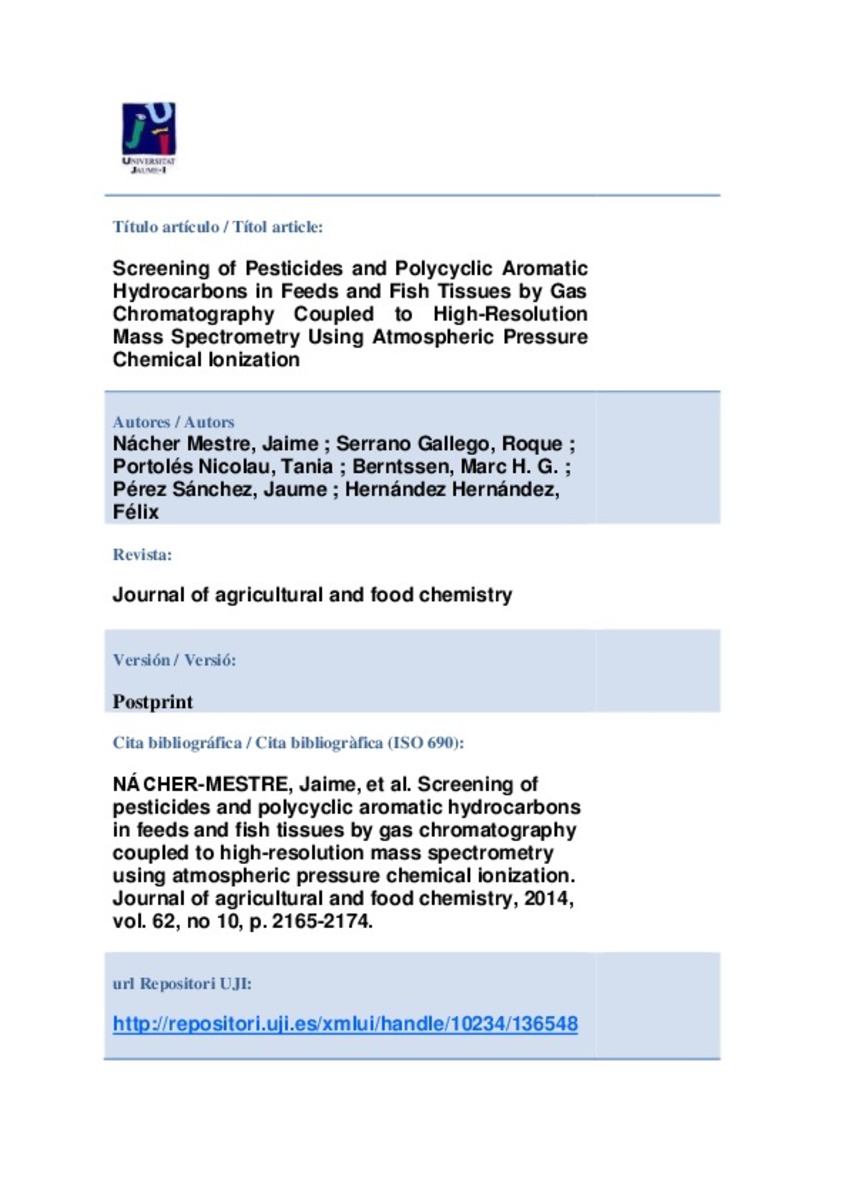Mostrar el registro sencillo del ítem
Screening of Pesticides and Polycyclic Aromatic Hydrocarbons in Feeds and Fish Tissues by Gas Chromatography Coupled to High-Resolution Mass Spectrometry Using Atmospheric Pressure Chemical Ionization
| dc.contributor.author | Nácher Mestre, Jaime | |
| dc.contributor.author | Serrano, Roque | |
| dc.contributor.author | Portoles, Tania | |
| dc.contributor.author | Berntssen, Marc H. G. | |
| dc.contributor.author | Pérez Sánchez, Jaume | |
| dc.contributor.author | Hernandez, Felix | |
| dc.date.accessioned | 2015-10-21T11:58:04Z | |
| dc.date.available | 2015-10-21T11:58:04Z | |
| dc.date.issued | 2014-02 | |
| dc.identifier.citation | NÁCHER-MESTRE, Jaime, et al. Screening of pesticides and polycyclic aromatic hydrocarbons in feeds and fish tissues by gas chromatography coupled to high-resolution mass spectrometry using atmospheric pressure chemical ionization. Journal of agricultural and food chemistry, 2014, vol. 62, no 10, p. 2165-2174. | ca_CA |
| dc.identifier.issn | 0021-8561 | |
| dc.identifier.issn | 1520-5118 | |
| dc.identifier.uri | http://hdl.handle.net/10234/136548 | |
| dc.description.abstract | This paper reports a wide-scope screening for detection and identification of pesticides and polycyclic aromatic hydrocarbons (PAHs) in feeds and fish tissues. QuEChERS sample treatment was applied, using freezing as an additional cleanup. Analysis was carried out by gas chromatography coupled to hybrid quadrupole time-of-flight mass spectrometry with atmospheric pressure chemical ionization (GC-(APCI) QTOF MS). The qualitative validation was performed for over 133 representative pesticides and 24 PAHs at 0.01 and 0.05 mg/kg. Subsequent application of the screening method to aquaculture samples made it possible to detect several compounds from the target list, such as chlorpyrifos-methyl, pirimiphos-methyl, and ethoxyquin, among others. Light PAHs (≤4 rings) were found in both animal and vegetable samples. The reliable identification of the compounds was supported by accurate mass measurements and the presence of at least two representative m/z ions in the spectrum together with the retention time of the peak, in agreement with the reference standard. Additionally, the search was widened to include other pesticides for which standards were not available, thanks to the expected presence of the protonated molecule and/or molecular ion in the APCI spectra. This could allow the detection and tentative identification of other pesticides different from those included in the validated target list. | ca_CA |
| dc.format.extent | 28 p. | ca_CA |
| dc.language.iso | eng | ca_CA |
| dc.publisher | American Chemical Society | ca_CA |
| dc.relation.isPartOf | Journal of agricultural and food chemistry, 2014, vol. 62, no 10 | ca_CA |
| dc.rights | Copyright © 2014 American Chemical Society | ca_CA |
| dc.rights.uri | http://rightsstatements.org/vocab/InC/1.0/ | * |
| dc.subject | gas chromatography | ca_CA |
| dc.subject | high-resolution mass spectrometry | ca_CA |
| dc.subject | QuEChERS | ca_CA |
| dc.subject | screening | ca_CA |
| dc.subject | organic contaminants | ca_CA |
| dc.subject | QTOF MS | ca_CA |
| dc.subject | feed | ca_CA |
| dc.subject | fish | ca_CA |
| dc.subject | qualitative validation | ca_CA |
| dc.title | Screening of Pesticides and Polycyclic Aromatic Hydrocarbons in Feeds and Fish Tissues by Gas Chromatography Coupled to High-Resolution Mass Spectrometry Using Atmospheric Pressure Chemical Ionization | ca_CA |
| dc.type | info:eu-repo/semantics/article | ca_CA |
| dc.identifier.doi | http:\\dx.doi.org/10.1021/jf405366n | |
| dc.rights.accessRights | info:eu-repo/semantics/openAccess | ca_CA |
| dc.relation.publisherVersion | http://pubs.acs.org/doi/abs/10.1021/jf405366n | ca_CA |
| dc.type.version | info:eu-repo/semantics/acceptedVersion |
Ficheros en el ítem
Este ítem aparece en la(s) siguiente(s) colección(ones)
-
QFA_Articles [829]
Articles de publicacions periòdiques







